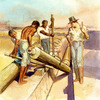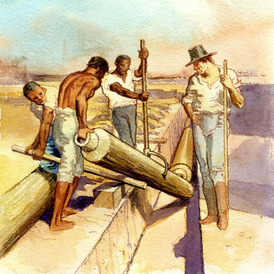Manhattan Company
The Manhattan Company was formed to bring fresh water to New Yorkers. Or at least that was its stated purpose. What the founders really wanted to do was to open a bank. In the end they did both. The Bank of the Manhattan Company, founded in 1799, was a huge success. Today it is known as JP Morgan Chase. The company’s mission to deliver fresh water to New Yorkers was not as successful, however.
The city in 1800 reached as far north as Chambers Street. Above that were widely spaced homes and farms along dirt roads. There were also slaughterhouses and places where animal hides were tanned—both very smelly businesses, located near what was once a supply of good fresh water called the Collect Pond.
The plan was to build a waterworks on Reade Street near the pond and pump the water around the city through a network of log pipes. It was a big job. About 25 miles of pipe had to be laid. The streets were paved with heavy cobblestones, which had to be torn up. Then a deep trench was dug and the hollowed pine logs -- each 13 feet long and 13 inches in diameter -- were laid in the trench and pounded together. Sand and earth were placed back in the trench, and any leftover dirt was carted away.
The laborers made one dollar a day, but if the worker was enslaved, his or her earnings went to the owner. At that time enslaved men and women were sometimes sent to the Slave Market at the end of Wall Street to hire themselves out. There were many free Africans in the city, too, but it was harder for them to get good-paying jobs.
This entry contributed by
Curriculum Concepts International
Related Media
Images

|
The Manhattan Company’s water system, which never worked very well, was replaced in 1842 when fresh drinking water began to flow into the city from Croton.
|

|
Around 1801 workers lay log water pipes along Broad Street as officials from the Manhattan Company look on. The workers laid 25 miles of pipe in the city’s first water system.
|
